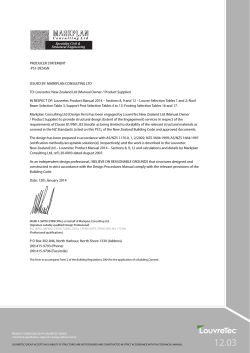
KS3 Chemistry 7E Acids and Alkalis © Boardworks Ltd 2004 1 of 20
KS3 Chemistry 7E Acids and Alkalis 1 of 20 34 © Boardworks Ltd 2004 Contents 7E Acids and Alkalis What are acids and alkalis? Hazard symbols Indicators and the pH scale Neutralization Summary activities 1 2 of 20 34 © Boardworks Ltd 2004 What is an acid? Acids are a group of chemicals. What do you know about acids? Are all acids dangerous? 1 3 of 20 34 © Boardworks Ltd 2004 What is an acid? Acids are a group of chemicals. Which of these items contains an acid? everyday acids laboratory acids Can you think of other examples of acids? 1 4 of 20 34 © Boardworks Ltd 2004 What is a weak acid? Acids are found in household items such as food, drink and beauty/skincare products. It is safe to handle these acids and even taste them, if they are for eating! These acids are known weak acids. 1 5 of 20 34 © Boardworks Ltd 2004 What is a strong acid? Some acids, like those found in the laboratory or a car battery, are very dangerous (too dangerous to taste or touch). These acids are said to be corrosive as they can damage other materials by wearing them away! They are strong acids. Why must strong acids always be handled very carefully? 1 6 of 20 34 © Boardworks Ltd 2004 What is an alkali? Alkalis are another group of chemicals, the opposite of acids. Which of these items contains an alkali? everyday alkalis laboratory alkalis Can you think of other examples of alkalis? 1 7 of 20 34 © Boardworks Ltd 2004 What is a weak alkali? Alkalis are found in soaps and other materials used for cleaning. It is safe to handle these alkalis, which can feel soapy. These alkalis are known as weak alkalis. 1 8 of 20 34 © Boardworks Ltd 2004 What is a strong alkali? Some alkalis, like those in the laboratory or in cleaning materials such as toilet cleaner, are too dangerous to touch. These alkalis are said to be caustic because they can burn skin and damage other materials! They are strong alkalis. Why must strong alkalis always be handled very carefully? 1 9 of 20 34 © Boardworks Ltd 2004 Contents 7E Acids and Alkalis What are acids and alkalis? Hazard symbols Indicators and the pH scale Neutralization Summary activities 1 10ofof20 34 © Boardworks Ltd 2004 What are hazard symbols? How can you tell which chemicals are safe and which are dangerous? Special symbols are used on bottles and vehicles that contain dangerous chemicals. i toxic irritant h harmful corrosive highly flammable These hazard symbols show why the chemical is dangerous. Why is it important that these symbols can be recognised by people from other countries? 1 11ofof20 34 © Boardworks Ltd 2004 What do hazard symbols mean? 1 12ofof20 34 © Boardworks Ltd 2004 Contents 7E Acids and Alkalis What are acids and alkalis? Hazard symbols Indicators and the pH scale Neutralization Summary activities 1 13ofof20 34 © Boardworks Ltd 2004 What is an indicator? How can you test a liquid to find if it is an acid or an alkali? An indicator is a special chemical that changes to a different colour in an acid or an alkali. Litmus paper and litmus solution are examples of indicators. Litmus is red in acid. 1 14ofof20 34 Litmus is blue in alkali. © Boardworks Ltd 2004 Litmus test experiment 1 15ofof20 34 © Boardworks Ltd 2004 What is universal indicator? Litmus is used to show if a solution is acid or alkali. Litmus does not show if the acid or alkali is weak or strong. Universal indicator has a range of colours that show how weak or strong the acid or alkali is. stronger acid strong acid stronger alkali weak weak acid neutral alkali strong alkali What is the colour for a weak acid? What is the colour for a strong alkali? 1 16ofof20 34 © Boardworks Ltd 2004 What is the pH scale? The strength of an acid or alkali is measured by the pH scale. Each universal indicator colour is given a number called the pH value. Universal indicator can tell you the pH of a solution. stronger acid stronger alkali 1 2 3 4 5 6 7 8 9 10 11 12 13 14 strong acid weak weak acid neutral alkali strong alkali What is the pH of a weak acid? What is the pH of strong alkali? 1 17ofof20 34 © Boardworks Ltd 2004 What is the pH? 1 18ofof20 34 © Boardworks Ltd 2004 What type of substance? Are these substances acidic or alkaline? Are they weak or strong? Substance soda water car battery acid 1 Description of acid/alkali very weak acid very strong acid soap 8 very weak alkali washing soda 10 weak alkali stomach acid 2 strong acid oven cleaner 14 very strong alkali vinegar 4 weak acid acid 1 19ofof20 34 pH 6 1 2 3 4 5 6 7 8 9 10 11 12 13 14 alkali © Boardworks Ltd 2004 Contents 7E Acids and Alkalis What are acids and alkalis? Hazard symbols Indicators and the pH scale Neutralization Summary activities 1 20ofof20 34 © Boardworks Ltd 2004 Mixing an acid and an alkali What happens when an acid and an alkali are mixed? ? Mixing an acid and an alkali causes a chemical change. This chemical change is called a chemical reaction. How do you know this chemical reaction has taken place? 1 21ofof20 34 © Boardworks Ltd 2004 What is neutralization? The chemical reaction between an acid and an alkali is called neutralization. acid alkali a salt water What happens to the pH value of the reaction mixture during neutralization? The pH value of the reaction mixture becomes closer to 7. 1 22ofof20 34 © Boardworks Ltd 2004 What is neutralization? The chemical reaction between an an acid and an alkali can be written as: acid alkali a salt water What are the two new substances produced by a neutralization reaction? 1 23ofof20 34 © Boardworks Ltd 2004 Neutralization and indigestion 1 24ofof20 34 © Boardworks Ltd 2004 Neutralizing stings 1 25ofof20 34 A bee sting is acidic. A wasp sting is alkaline. Why can bicarbonate of soda (pH 9) be used to treat a bee sting? Why can vinegar (pH 3) be used to treat a wasp sting? © Boardworks Ltd 2004 Neutralizing soil Soils in different places can be acidic, alkaline or neutral. Many plants do not grow well in acidic soil. Why do farmers test soil to check the pH? Farmers often add an alkali to acidic soil to make their plants grow better. How does the alkali help to treat the acidic soil? 1 26ofof20 34 © Boardworks Ltd 2004 Neutralizing acid rain Gases emitted by cars, power stations and factories mix with rainwater in the atmosphere. This rainwater has a pH <5.5. Why is it called acid rain? Acid rain can have a harmful effect on the environment killing trees, polluting lakes and damaging buildings. How can the effects of acid rain be prevented? 1 27ofof20 34 © Boardworks Ltd 2004 Contents 7E Acids and Alkalis What are acids and alkalis? Hazard symbols Indicators and the pH scale Neutralization Summary activities 1 28ofof20 34 © Boardworks Ltd 2004 Glossary acid – A chemical that has a pH less than 7. alkali – A chemical that has a pH greater than 7 and dissolves in water. indicator – A special chemical that changes into different 1 29ofof20 34 colours in acid and alkali solutions. neutral – A chemical with a pH of 7 that is not an acid or an alkali. neutralization – The chemical reaction between an acid and an alkali. pH scale – The range of values that shows how strong or weak an acid or alkali is. universal indicator – The indicator that shows the pH value of a chemical. © Boardworks Ltd 2004 Anagrams 1 30ofof20 34 © Boardworks Ltd 2004 Word search 1 31ofof20 34 © Boardworks Ltd 2004 Facts about acids Weak acids, like lemon juice and vinegar, taste sour. Strong acids are corrosive and can “eat away” at metal, stone and flesh! Acids turns blue litmus paper red. Acids have a pH of less than 7. Acids can be neutralized with alkalis. 1 32ofof20 34 © Boardworks Ltd 2004 Facts about alkalis Alkalis feel soapy and are used in household cleaning materials. Strong alkalis are caustic. Alkalis turn red litmus paper blue. Alkalis have a pH of more than 7. Alkalis can be neutralized with acids. 1 33ofof20 34 © Boardworks Ltd 2004 Multiple-choice quiz 1 34ofof20 34 © Boardworks Ltd 2004
© Copyright 2025









